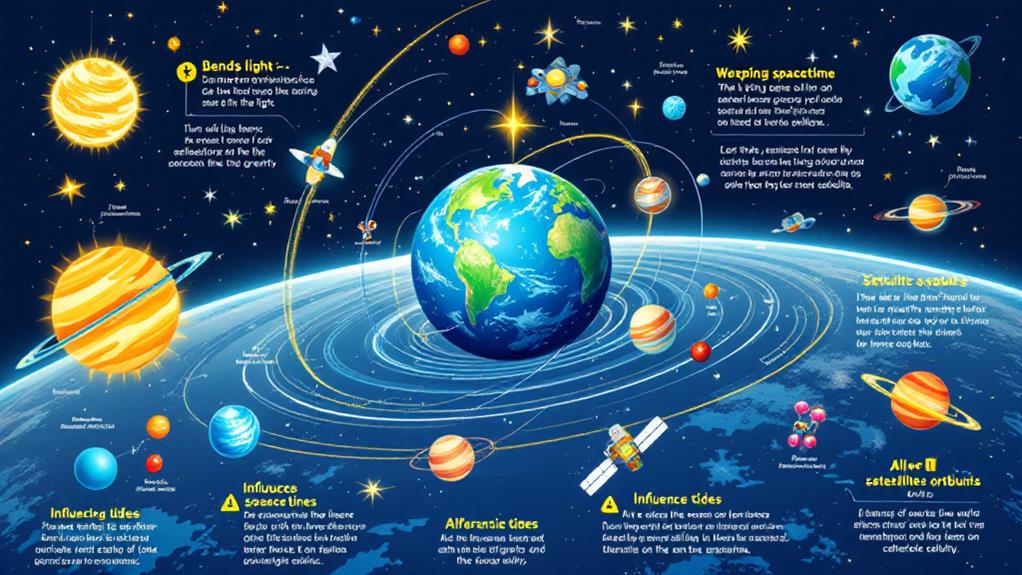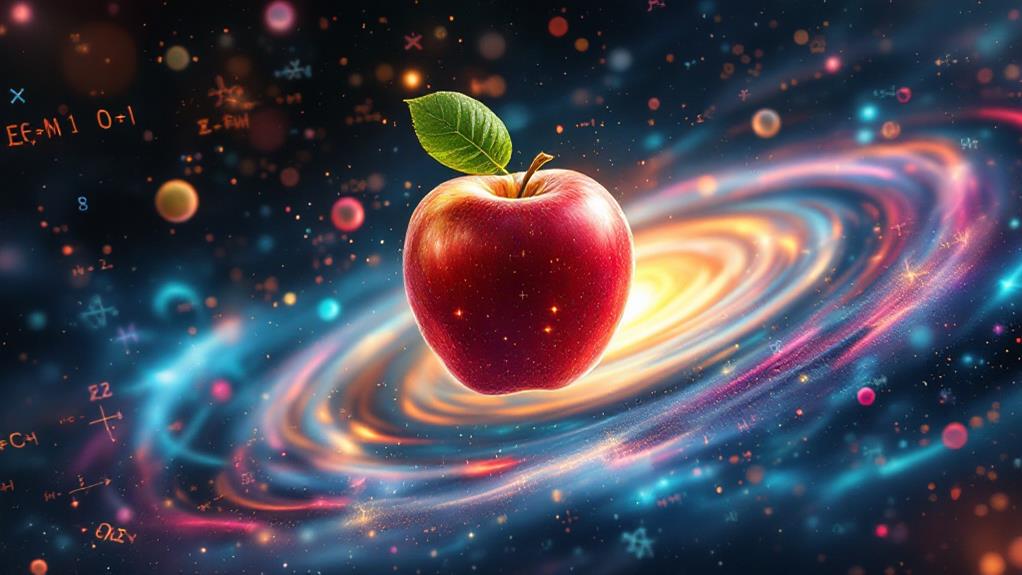Fun Facts About Physics: Exploring the Wonders of the Physical World

Physics reveals a universe far stranger and more alluring than you might imagine. You'll explore quantum particles that exist in multiple states simultaneously, time that slows down near black holes, and light that behaves as both a wave and a particle. You'll learn about gravity's ability to bend light and create ripples in space-time. Even everyday phenomena, like the mesmerizing motion of lava lamps, are governed by fascinating physical principles. From the mind-bending realm of quantum mechanics to the cosmic mysteries of black holes, physics offers a repository of astonishing facts that challenge our understanding of reality. Plunge deeper to uncover more mind-blowing revelations about our physical world.
Quantum Weirdness
Quantum mechanics' bizarre nature often baffles even seasoned physicists. When you immerse into this microscopic field, you'll encounter phenomena that defy common sense. One such oddity is quantum tunneling, where particles can pass through seemingly impenetrable barriers. This process explains how nuclear fusion occurs in stars and enables the function of scanning tunneling microscopes.
Another mind-bending concept is superposition, where particles exist in multiple states simultaneously until observed. This leads to paradoxes like Schrödinger's cat, which is theoretically both alive and dead until the box is opened. You'll also encounter the observer effect, where the act of measurement influences the outcome of an experiment.
Quantum entanglement adds to the weirdness, allowing particles to instantly communicate across vast distances, seemingly faster than light. This "spooky action at a distance," as Einstein called it, challenges our understanding of causality and locality.
As you investigate quantum mechanics, you'll find that the rules governing the subatomic world are fundamentally different from those we experience in our everyday lives, constantly pushing the boundaries of our understanding of reality.
Time's Elastic Nature
While quantum mechanics challenges our understanding of the microscopic world, Einstein's theory of relativity upends our perception of time itself. You might think time flows at a constant rate, but it's actually elastic and can stretch or compress depending on your circumstances.
Time dilation, a key concept in relativity, shows that time passes more slowly for objects moving at high speeds or in strong gravitational fields. If you were to embark on a space expedition, you'd experience time more slowly than someone on Earth. This temporal distortion means you could theoretically return from a space expedition to find that more time has passed on Earth than you've experienced.
Gravity also warps time. The stronger the gravitational field, the slower time moves. This effect is measurable even on Earth—clocks at sea level tick slightly faster than those on mountaintops. In extreme cases, like near black holes, time can slow dramatically or even stop altogether.
These mind-bending concepts reveal that time isn't absolute but relative, changing based on your speed and location in the universe.
Black Hole Mysteries

Enigmas of the cosmos, black holes remain some of the most fascinating and perplexing objects in our universe. These gravitational powerhouses are so dense that nothing, not even light, can escape their grasp once it crosses the event horizon. You might wonder how these cosmic giants come into existence. The process of singularity formation occurs when a massive star collapses under its own gravity, compressing all its matter into an infinitely small point.
But black holes aren't just about swallowing everything in sight. Surprisingly, they can actually shrink over time through a process called black hole evaporation. This phenomenon, theorized by Stephen Hawking, suggests that black holes emit a faint radiation, slowly losing mass over incredibly long periods. You'd be amazed to learn that a black hole the mass of our Sun would take an unimaginable 10^67 years to evaporate completely!
Scientists are still uncovering the mysteries surrounding these cosmic behemoths. From studying gravitational waves to capturing the first-ever image of a black hole, our understanding continues to evolve, challenging our perceptions of space, time, and the fundamental nature of our universe.
Light's Dual Personality
Light, the ever-present phenomenon that illuminates our world, harbors a fascinating secret: it behaves as both a wave and a particle. This dual nature, known as wave-particle duality, has puzzled physicists for centuries and continues to challenge our understanding of the universe.
When you observe light's wave-like properties, you'll notice it exhibits behaviors such as:
- Diffraction: Light bends around obstacles
- Interference: Light waves combine to create patterns
- Refraction: Light changes direction when passing through different mediums
- Polarization: Light waves oscillate in specific directions
These properties are evident in everyday phenomena. You've likely seen refractive index variations when looking at a straw in a glass of water, or experienced light polarization patterns when wearing polarized sunglasses.
However, light also behaves as a particle, called a photon. This particle nature explains how light interacts with matter at the atomic level, such as in the photoelectric effect. Einstein's work on this phenomenon earned him a Nobel Prize and revolutionized our understanding of light's dual personality. As you explore deeper into the world of physics, you'll uncover that this duality is a fundamental aspect of quantum mechanics.
Gravity's Hidden Influences

Gravity, often taken for granted, exerts its influence far beyond simply keeping our feet on the ground. It's a fundamental force that shapes the universe in ways you might not expect. For instance, did you know that gravity can bend light? This phenomenon, called gravitational lensing, occurs when massive objects like galaxies or black holes warp space-time, causing light to follow a curved path. Astronomers use this effect to study distant celestial bodies that would otherwise be invisible to us.
But gravity's hidden influences don't stop there. In 2015, scientists made an important discovery: gravitational waves. These ripples in space-time, predicted by Einstein a century ago, are produced by cataclysmic events like colliding black holes or neutron stars. By detecting these waves, we can now "listen" to the universe in a whole new way, gaining perspectives into cosmic events that were previously unobservable. Gravity also plays a pivotal role in Earth's tides, the formation of galaxies, and even the rate at which time passes. The next time you feel your weight, remember: you're experiencing just one aspect of gravity's vast cosmic influence.
Everyday Physics Phenomena
Physics isn't just confined to laboratories or the cosmos; it's constantly at play in our everyday lives. From the moment you wake up to the time you go to bed, you're surrounded by fascinating physical phenomena. The way your coffee swirls in your mug, the steam rising from your shower, and even the sound of your voice are all governed by the laws of physics.
Here are four everyday physics phenomena you might encounter:
- Density fluctuations in your lava lamp
- Thermal conduction when you touch a cold surface
- Refraction of light through your glasses or contact lenses
- Friction as you walk across different surfaces
You might not realize it, but density fluctuations are responsible for the mesmerizing motion of lava lamps. As the wax heats up, it becomes less dense and rises, then cools and sinks again. Thermal conduction is at work when you touch a cold surface and feel the heat leaving your hand. It's these subtle yet omnipresent physical processes that make our world function as it does, reminding us that physics is not just a subject in school, but an integral part of our daily lives.



